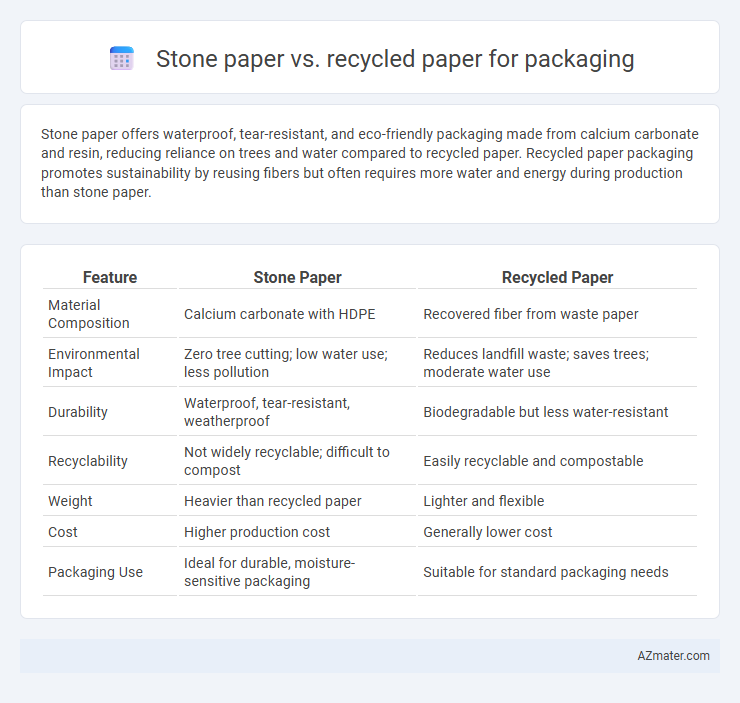Stone paper offers waterproof, tear-resistant, and eco-friendly packaging made from calcium carbonate and resin, reducing reliance on trees and water compared to recycled paper. Recycled paper packaging promotes sustainability by reusing fibers but often requires more water and energy during production than stone paper.
Table of Comparison
| Feature | Stone Paper | Recycled Paper |
|---|---|---|
| Material Composition | Calcium carbonate with HDPE | Recovered fiber from waste paper |
| Environmental Impact | Zero tree cutting; low water use; less pollution | Reduces landfill waste; saves trees; moderate water use |
| Durability | Waterproof, tear-resistant, weatherproof | Biodegradable but less water-resistant |
| Recyclability | Not widely recyclable; difficult to compost | Easily recyclable and compostable |
| Weight | Heavier than recycled paper | Lighter and flexible |
| Cost | Higher production cost | Generally lower cost |
| Packaging Use | Ideal for durable, moisture-sensitive packaging | Suitable for standard packaging needs |
Overview: Stone Paper vs Recycled Paper for Packaging
Stone paper, made from calcium carbonate and a small amount of resin, offers water resistance, durability, and tear-proof qualities ideal for packaging. Recycled paper, produced from reused fibers, emphasizes environmental sustainability by reducing deforestation and waste but may lack the waterproof and strength features of stone paper. Both materials serve distinct packaging needs, with stone paper excelling in durability and recycled paper prioritizing eco-friendly credentials.
What is Stone Paper? Composition and Properties
Stone paper is made from calcium carbonate bonded with high-density polyethylene, creating a durable and waterproof material that is tear-resistant and smooth to the touch. Unlike traditional recycled paper, stone paper does not require water or bleaching processes, making it an eco-friendly alternative with a lower environmental footprint. Its unique composition offers superior strength, moisture resistance, and longevity, ideal for packaging applications that demand durability.
What is Recycled Paper? Sources and Characteristics
Recycled paper is produced by processing used paper products to reduce waste and conserve natural resources, sourced mainly from post-consumer and post-industrial paper waste such as office documents, newspapers, and cardboard. Its characteristics include reduced environmental impact through lower energy consumption and decreased deforestation, often resulting in a slightly lower strength and brightness compared to virgin paper. This paper type is widely used in eco-friendly packaging solutions due to its sustainability, recyclability, and cost-effectiveness.
Environmental Impact: Stone Paper vs Recycled Paper
Stone paper, made from calcium carbonate and resin, offers a waterless production process that reduces deforestation and lowers carbon emissions compared to traditional paper. Recycled paper minimizes waste by reusing fibers, significantly reducing landfill impact and energy consumption in manufacturing. While stone paper is waterproof and durable with longer life cycles, recycled paper excels in biodegradability and compostability, making each suitable for different sustainable packaging needs.
Durability and Performance in Packaging Applications
Stone paper offers superior durability and water resistance compared to recycled paper, making it ideal for packaging applications requiring tear resistance and moisture protection. Recycled paper, while eco-friendly, tends to have lower strength and can degrade faster when exposed to environmental factors such as humidity. In high-performance packaging scenarios, stone paper ensures longevity and maintains structural integrity better than recycled alternatives.
Printability and Visual Appeal Comparison
Stone paper offers superior printability due to its smooth, non-porous surface, resulting in sharper images and vibrant colors compared to recycled paper. Recycled paper often has a rougher texture and uneven fiber distribution, which can cause ink absorption inconsistencies and muted visual appeal. The durability and moisture resistance of stone paper also contribute to maintaining print quality and enhancing packaging aesthetics over time.
Cost Analysis: Stone Paper and Recycled Paper
Stone paper generally offers higher durability and water resistance at a production cost 20-30% above recycled paper, impacting packaging budgets. Recycled paper, produced from post-consumer waste, tends to have lower raw material expenses, making it a cost-effective choice for large-volume packaging. However, stone paper's longer lifespan and reduced need for additional coatings can offset initial expenses over time, influencing total cost considerations.
Water and Energy Consumption in Production
Stone paper production consumes significantly less water compared to recycled paper, as it eliminates the need for pulping processes that require vast amounts of water. Energy consumption for stone paper is also lower due to its synthetic composition, which bypasses the energy-intensive recycling and bleaching stages typical in recycled paper manufacturing. These efficiencies make stone paper a sustainable alternative, reducing both water usage and energy demands in packaging production.
End-of-Life: Recycling and Decomposition Options
Stone paper, composed mainly of calcium carbonate bound with resin, is non-biodegradable but recyclable through specialized processes that separate the plastic binder, though these facilities are not widespread. Recycled paper packaging, made from post-consumer fibers, is highly recyclable in conventional paper recycling systems and decomposes naturally within weeks in composting environments. The end-of-life management favors recycled paper due to its widespread recyclability and rapid biodegradation, whereas stone paper's environmental impact depends on access to specific recycling infrastructure and its limited decomposition options.
Choosing the Right Material for Sustainable Packaging
Stone paper offers a waterproof, tear-resistant alternative to recycled paper, making it ideal for durable packaging solutions that reduce plastic use. Recycled paper supports circular waste management by repurposing fiber materials, lowering deforestation and energy consumption in production. Selecting the right material depends on product protection needs, environmental impact goals, and end-of-life recyclability to ensure truly sustainable packaging.

Infographic: Stone paper vs Recycled paper for Packaging
 azmater.com
azmater.com